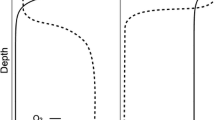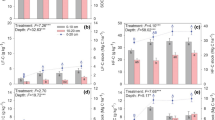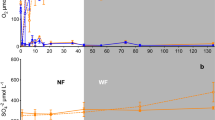Abstract
Nutrient cations can limit plant productivity in highly weathered soils, but have received much less attention than phosphorus and nitrogen. The reduction of iron (Fe) in anaerobic microsites of surface soils can solubilize organic matter and P sorbed or occluded with short-range-ordered (SRO) Fe phases. This mechanism might also release occluded cations. In the Luquillo Experimental Forest, Puerto Rico, we measured cation release during anaerobic laboratory incubations, and assessed patterns of cation availability in surface soils spanning ridge-slope-valley catenas. During anaerobic incubations, potassium (K), calcium (Ca) and magnesium (Mg) significantly increased with reduced Fe (Fe(II)) in both water and 0.5 M HCl extractions, but did not change during aerobic incubations. In the field, 0.5 M HCl-extractable Fe(II) and Fe(III) were the strongest predictors of K, Mg, and Ca on ridges (R2 0.57–0.75). Here, both Ca and Mg decreased with Fe(III), while K, Ca, and Mg increased with Fe(II), consistent with release of Fe-occluded cations following Fe reduction. Manganese in ridge soils was extremely low, consistent with leaching following reductive dissolution of Mn(IV). On slopes, soil C was the strongest cation predictor, consistent with the importance of organic matter for cation exchange in these highly weathered Oxisols. In riparian valleys, cation concentrations were up to 16-fold greater than in other topographic positions but were weakly or unrelated to measured predictors, potentially reflecting cation-rich groundwater. Predictors of cation availability varied with topography, but were consistent with the potential importance of microsite Fe reduction in liberating occluded cations, particularly in the highly productive ridges. This mechanism may explain discrepancies among indices of “available” soil cations and plant cation uptake observed in other tropical forests.





Similar content being viewed by others
References
Baribault TW, Kobe RK, Finley AO (2011) Tropical tree growth is correlated with soil phosphorus, potassium, and calcium, though not for legumes. Ecol Monogr 82:189–203. doi:10.1890/11-1013.1
Brinkman R (1970) Ferrolysis, a hydromorphic soil forming process. Geoderma 3:199–206. doi:10.1016/0016-7061(70)90019-4
Buettner SW, Kramer MG, Chadwick OA, Thompson A (2014) Mobilization of colloidal carbon during iron reduction in basaltic soils. Geoderma 221–222:139–145. doi:10.1016/j.geoderma.2014.01.012
Chacon N, Silver WL, Dubinsky EA, Cusack DF (2006) Iron reduction and soil phosphorus solubilization in humid tropical forest soils: the roles of labile carbon pools and an electron shuttle compound. Biogeochemistry 78:67–84. doi:10.1007/s10533-005-2343-3
Chadwick OA, Derry LA, Vitousek PM et al (1999) Changing sources of nutrients during four million years of ecosystem development. Nature 397:491–497. doi:10.1038/17276
Cleveland CC, Townsend AR, Taylor P et al (2011) Relationships among net primary productivity, nutrients and climate in tropical rain forest: a pan-tropical analysis. Ecol Lett 14:939–947. doi:10.1111/j.1461-0248.2011.01658.x
Cornell RM, Schwertmann U (1996) The Iron Oxides: Structure, Properties, Reactions. Occurrences and Uses. John Wiley & Sons, Hoboken
Cuevas E, Medina E (1988) Nutrient dynamics within Amazonian forests. II. Fine root growth, nutrient availability and leaf litter decomposition. Oecologia 76:222–235
Dubinsky EA, Silver WL, Firestone MK (2010) Tropical forest soil microbial communities couple iron and carbon biogeochemistry. Ecology 91:2604–2612. doi:10.1890/09-1365.1
Fabris JD, de Jesus Filho MF, Coey JMD et al (1997) Iron-rich spinels from Brazilian soils. Hyperfine Interact 110:23–32. doi:10.1023/A:1012619331408
Gee G, Bauder J (1986) Particle size analysis. In: Klute A (ed) Methods of soil analysis, Part 1, physical and mineralogical methods, 2nd edn. American Society of Agronomy, Madison, pp 383–411
Ginn BR, Habteselassie MY, Meile C, Thompson A (2014) Effects of sample storage on microbial Fe-reduction in tropical rainforest soils. Soil Biol Biochem 68:44–51. doi:10.1016/j.soilbio.2013.09.012
Ginn B, Meile C, Wilmoth J et al (2017) Rapid iron reduction rates are stimulated by high-amplitude redox fluctuations in a tropical forest soil. Environ Sci Technol 51:3250–3259. doi:10.1021/acs.est.6b05709
Giovanoli R, Cornell RM (1992) Crystallization of metal substituted ferrihydrites. Z Für Pflanzenernähr Bodenkd 155:455–460. doi:10.1002/jpln.19921550517
Grybos M, Davranche M, Gruau G, Petitjean P (2007) Is trace metal release in wetland soils controlled by organic matter mobility or Fe-oxyhydroxides reduction? J Colloid Interface Sci 314:490–501. doi:10.1016/j.jcis.2007.04.062
Hall SJ, Silver WL (2015) Reducing conditions, reactive metals, and their interactions can explain spatial patterns of surface soil carbon in a humid tropical forest. Biogeochemistry 125:149–165. doi:10.1007/s10533-015-0120-5
Hall SJ, McDowell WH, Silver WL (2013) When wet gets wetter: decoupling of moisture, redox biogeochemistry, and greenhouse gas fluxes in a humid tropical forest soil. Ecosystems 16:576–589. doi:10.1007/s10021-012-9631-2
Hall SJ, Treffkorn J, Silver WL (2014) Breaking the enzymatic latch: impacts of reducing conditions on hydrolytic enzyme activity in tropical forest soils. Ecology 95:2964–2973. doi:10.1890/13-2151.1
Hall SJ, Liptzin D, Buss HL et al (2016) Drivers and patterns of iron redox cycling from surface to bedrock in a deep tropical forest soil: a new conceptual model. Biogeochemistry 130:177–190. doi:10.1007/s10533-016-0251-3
Henderson R, Kabengi N, Mantripragada N et al (2012) Anoxia-induced release of colloid- and nanoparticle-bound phosphorus in grassland soils. Environ Sci Technol 46:11727–11734. doi:10.1021/es302395r
Huang W, Hall SJ (2017) Optimized high-throughput methods for quantifying iron biogeochemical dynamics in soil. Geoderma 306:67–72. doi:10.1016/j.geoderma.2017.07.013
Jenny H, Leonard C (1934) Functional relationships between soil properties and rainfall. Soil Sci 38:363–381
Johnson AH, Frizano J, Vann DR (2003) Biogeochemical implications of labile phosphorus in forest soils determined by the Hedley fractionation procedure. Oecologia 135:487–499. doi:10.1007/s00442-002-1164-5
Johnson AH, Xing HX, Scatena FN (2015) Controls on soil carbon stocks in El Yunque National Forest, Puerto Rico. Soil Sci Soc Am J 79:294. doi:10.2136/sssaj2014.05.0199
Kaspari M, Garcia MN, Harms KE et al (2008) Multiple nutrients limit litterfall and decomposition in a tropical forest. Ecol Lett 11:35–43. doi:10.1111/j.1461-0248.2007.01124.x
Kleber M, Eusterhues K, Keiluweit M et al (2015) Mineral–organic associations: formation, properties, and relevance in soil environments. In: Advances in agronomy. Elsevier, pp 1–140
Liptzin D, Silver WL (2009) Effects of carbon additions on iron reduction and phosphorus availability in a humid tropical forest soil. Soil Biol Biochem 41:1696–1702
Liptzin D, Silver WL, Detto M (2011) Temporal dynamics in soil oxygen and greenhouse gases in two humid tropical forests. Ecosystems 14:171–182. doi:10.1007/s10021-010-9402-x
Lloyd J, Domingues TF, Schrodt F et al (2015) Edaphic, structural and physiological contrasts across Amazon Basin forest–savanna ecotones suggest a role for potassium as a key modulator of tropical woody vegetation structure and function. Biogeosciences 12:6529–6571. doi:10.5194/bg-12-6529-2015
Lovley DR, Phillips EJP (1987) Rapid assay for microbially reducible ferric iron in aquatic sediments. Appl Environ Microbiol 53:1536–1540
Markewitz D, Davidson EA, de O Figueiredo R et al (2001) Control of cation concentrations in stream waters by surface soil processes in an Amazonian watershed. Nature 410:802–805. doi:10.1038/35071052
McBride MB (1978) Retention of Cu2+, Ca2+, Mg2+, and Mn2+ by amorphous alumina. Soil Sci Soc Am J 42:27. doi:10.2136/sssaj1978.03615995004200010007x
McBride MB (1989) Reactions controlling heavy metal solubility in soils. In: Stewart BA (ed) Advances in Soil Science. Springer, New York, pp 1–56
McDowell WH (1998) Internal nutrient fluxes in a Puerto Rican rain forest. J Trop Ecol 14:521–536
McDowell WH, Asbury CE (1994) Export of carbon, nitrogen, and major ions from three tropical montane watersheds. Limnol Oceanogr 39:111–125. doi:10.4319/lo.1994.39.1.0111
McDowell WH, Bowden WB, Asbury CE (1992) Riparian nitrogen dynamics in two geomorphologically distinct tropical rain forest watersheds: subsurface solute patterns. Biogeochemistry 18:53–75
McKenzie RM (1989) Manganese oxides and hydroxides. In: Dixon JB, Weed SB (eds) Minerals in soil environments, pp 439–465
Pan W, Kan J, Inamdar S et al (2016) Dissimilatory microbial iron reduction release DOC (dissolved organic carbon) from carbon-ferrihydrite association. Soil Biol Biochem 103:232–240. doi:10.1016/j.soilbio.2016.08.026
Peretyazhko T, Sposito G (2005) Iron(III) reduction and phosphorous solubilization in humid tropical forest soils. Geochim Cosmochim Acta 69:3643–3652. doi:10.1016/j.gca.2005.03.045
Phillips IR, Greenway M (1998) Changes in water-soluble and exchangeable ions, cation exchange capacity, and phosphorus max in soils under alternating waterlogged and drying conditions. Commun Soil Sci Plant Anal 29:51–65. doi:10.1080/00103629809369928
Pinheiro J, Bates D, DebRoy S et al (2014) nlme: linear and nonlinear mixed effects models
Porder S, Johnson AH, Xing HX et al (2015) Linking geomorphology, weathering and cation availability in the Luquillo Mountains of Puerto Rico. Geoderma 249–250:100–110. doi:10.1016/j.geoderma.2015.03.002
Ramirez Romero G (1950) Exchangeable cations extracted by 0.1 N hydrochloric acid and ammonium acetate in soils of the Valle. Acta Agron 1:51–56
Rietra RPJJ, Hiemstra T, van Riemsdijk WH (2001) Interaction between calcium and phosphate adsorption on goethite. Environ Sci Technol 35:3369–3374. doi:10.1021/es000210b
Russell AE, Hall SJ, Raich JW (2017) Tree species impact cation dynamics in a tropical rainforest: a new conceptual framework. Ecol Monogr. doi:10.1002/ecm.1274
Sanchez PA (1976) Properties and management of soils in the tropics. Wiley, New York
Scatena FN, Lugo AE (1995) Geomorphology, disturbance, and the soil and vegetation of two subtropical wet steepland watersheds of Puerto Rico. Geomorphology 13:199–213. doi:10.1016/0169-555X(95)00021-V
Schwertmann U (1991) Solubility and dissolution of iron oxides. Plant Soil 130:1–25
Silver WL, Vogt KA (1993) Fine-root dynamics following single and multiple disturbances in a subtropical wet forest ecosystem. J Ecol 81:729–738
Silver WL, Scatena FN, Johnson AH et al (1994) Nutrient availability in a montane wet tropical forest—spatial patterns and methodological considerations. Plant Soil 164:129–145
Singh KD, Goulding KWT, Sinclair AH (1983) Assessment of potassium in soils. Commun Soil Sci Plant Anal 14:1015–1033. doi:10.1080/00103628309367429
Soil Survey Staff (2002) Soil survey of Caribbean National Forest and Luquillo Experimental Forest, Commonwealth of Puerto Rico. United States Department of Agriculture, Natural Resources Conservation Service
Taylor RM, Graley AM (1967) The influence of ionic environment on the nature of iron oxides in soils. J Soil Sci 18:341–348. doi:10.1111/j.1365-2389.1967.tb01512.x
Thompson A, Chadwick OA, Boman S, Chorover J (2006) Colloid mobilization during soil iron redox oscillations. Environ Sci Technol 40:5743–5749. doi:10.1021/es061203b
Thompson A, Rancourt D, Chadwick O, Chorover J (2011) Iron solid-phase differentiation along a redox gradient in basaltic soils. Geochim Cosmochim Acta 75:119–133. doi:10.1016/j.gca.2010.10.005
Tishchenko V, Meile C, Scherer MM et al (2015) Fe2 + catalyzed iron atom exchange and re-crystallization in a tropical soil. Geochim Cosmochim Acta 148:191–202. doi:10.1016/j.gca.2014.09.018
Unger M, Leuschner C, Homeier J (2010) Variability of indices of macronutrient availability in soils at different spatial scales along an elevation transect in tropical moist forests (NE Ecuador). Plant Soil 336:443–458. doi:10.1007/s11104-010-0494-z
Vitousek P, Sanford R (1986) Nutrient cycling in moist tropical forest. Annu Rev Ecol Syst 17:137–167
Walker TW, Syers JK (1976) The fate of phosphorus during pedogenesis. Geoderma 15:1–19. doi:10.1016/0016-7061(76)90066-5
Wright SJ, Yavitt JB, Wurzburger N et al (2011) Potassium, phosphorus, or nitrogen limit root allocation, tree growth, or litter production in a lowland tropical forest. Ecology 92:1616–1625. doi:10.1890/10-1558.1
Yi-Balan SA, Amundson R, Buss HL (2014) Decoupling of sulfur and nitrogen cycling due to biotic processes in a tropical rainforest. Geochim Cosmochim Acta 142:411–428. doi:10.1016/j.gca.2014.05.049
Acknowledgements
This work was supported by NSF grant DEB-1457805, by the NSF Luquillo Critical Zone Observatory, and by Iowa State University. SJH gratefully acknowledges mentorship by W. Silver on related research at this site. We thank A. Russell for discussion about the conceptual model, S. Rathke and S. Bakshi for assistance with ICP analyses, the USFS International Institute of Tropical Forestry for logistical support, and O. Gutierrez del Arroyo for collecting soil for the incubation experiment.
Author information
Authors and Affiliations
Corresponding author
Additional information
Responsible Editor: James Sickman.
Rights and permissions
About this article
Cite this article
Hall, S.J., Huang, W. Iron reduction: a mechanism for dynamic cycling of occluded cations in tropical forest soils?. Biogeochemistry 136, 91–102 (2017). https://doi.org/10.1007/s10533-017-0383-0
Received:
Accepted:
Published:
Issue Date:
DOI: https://doi.org/10.1007/s10533-017-0383-0




